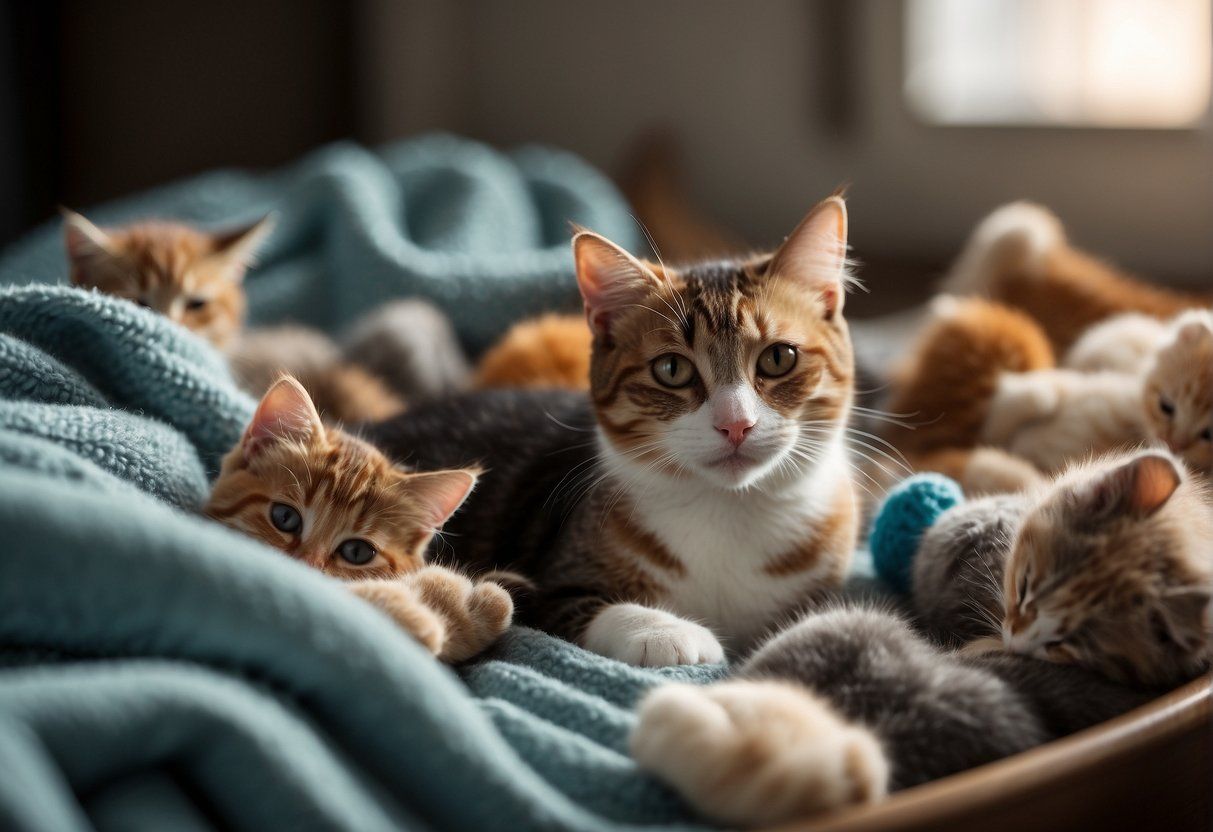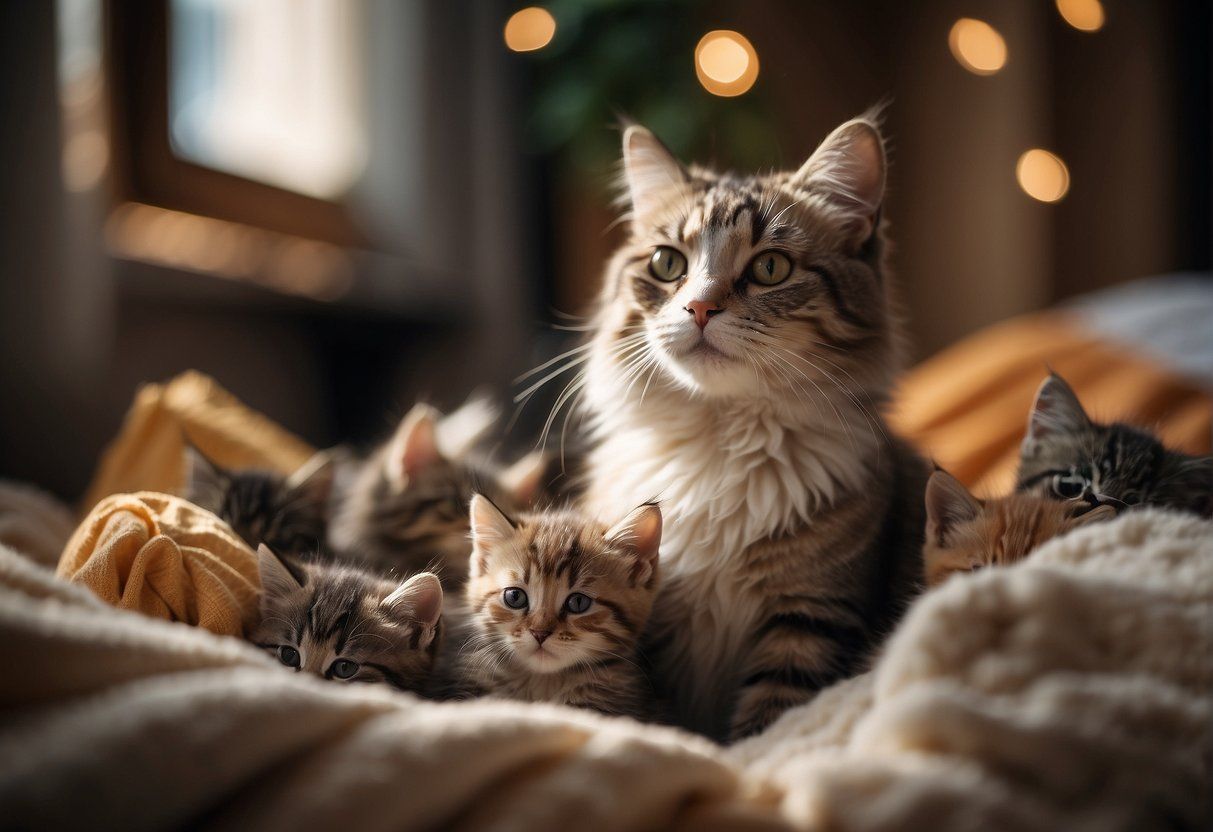How Many Litters is Safe for a Cat to Have? Vet Answered
How Many Litters is Safe for a Cat to Have? Vet Answered

Vet Reviewed

By: Sarah Hodgson
February 18, 2024
- Posted in Cats
Table of Contents
Cats are adorable creatures that are known to be excellent companions. And when it comes to breeds and cat lovers they tend to breed their cats. However, the question of how many litters it is safe for a cat to have is a critical one that every cat owner should consider.
In this article, we will explore the health risks of frequent breeding and responsible breeding practices that every cat owner should consider.
Let's dive in!
Quick Answer:
It is recommended that a cat should have no more than 3 litters in a year and no more than 7 litters in its lifetime. However, it is important to note that each cat is unique, and factors such as age, health, and breed should be taken into consideration.
Understanding Feline Reproduction
Female cats become sexually mature at around six months of age, at which point they enter their first heat cycle. The heat cycle is also known as estrus and refers to the period when a female cat is fertile and receptive to mating. The heat cycle typically lasts around a week, during which time the female cat may exhibit behaviors such as increased vocalization, restlessness, and rubbing against objects.
Gestation Period in Cats
If a female cat mates during her heat cycle and becomes pregnant, the gestation period typically lasts around 63-65 days. During this time, it is important to monitor the cat's health and nutrition to ensure that she and her developing kittens are healthy. Regular veterinary check-ups and ultrasounds can also help to detect any potential issues early on in the pregnancy.
Factors Affecting Litter Size
The size of a litter can be influenced by a variety of factors, including genetics, health, nutrition, and environmental factors. Some cat breeds are more likely to have larger litters than others, while a cat's overall health and nutrition can also impact litter size. Environmental factors such as stress can also affect the size of a litter. It is important to provide a safe and comfortable environment for pregnant cats to help ensure the health of both the mother and her kittens.

Health Risks of Frequent Breeding
Breeding cats is a process that requires careful consideration and planning. While it can be tempting to breed a female cat frequently, it is important to understand the potential health risks associated with this practice.
Physical Impact on Female Cats
Frequent breeding can take a toll on a female cat's physical health. The process of pregnancy and delivery can be exhausting, and repeated pregnancies can lead to physical strain and stress on the body. This can result in a lower quality of life for the cat, as well as potential health issues such as uterine infections and other reproductive disorders.
Potential Complications During Pregnancy
Pregnancy can also carry risks for both the mother and her kittens. Frequent breeding can increase the likelihood of complications during pregnancy, such as premature delivery or stillbirth. Additionally, older cats may be at higher risk for complications during delivery, which can lead to serious health issues or even death.
Long-Term Health Concerns
Overbreeding can also have long-term health implications for female cats. Studies have shown that cats who are spayed have a lower risk of developing certain types of cancer, such as ovarian and uterine cancer. Additionally, geriatric cats who have been bred frequently may experience a lower quality of life in their later years, due to the physical toll that breeding can take on their bodies.
It is important for breeders to work closely with a veterinarian to ensure that their cats are healthy and not being overbred. By being aware of the potential risks associated with frequent breeding, breeders can help to ensure the health and well-being of their cats and their kittens.
Responsible Breeding Practices
When it comes to breeding cats, responsible breeding practices are essential to ensure the health and safety of the cats involved and to prevent overpopulation. Here are some key considerations for responsible breeding practices:
Breeding Frequency Recommendations
It is generally recommended that cats should not be bred more than once a year. This allows the cat's body to fully recover from the stress of pregnancy and birth and reduces the risk of health complications. Additionally, breeding cats too frequently can lead to overpopulation and an increased risk of unwanted pregnancies.
The Role of Veterinarians
Veterinarians play a crucial role in responsible breeding practices. They can perform health checks on cats prior to breeding to ensure that they are in good health and free of any underlying conditions that could affect their ability to carry and deliver healthy kittens. They can also perform ultrasounds and x-rays to monitor the health of the kittens during pregnancy and ensure that they are developing properly.
Controlling Cat Population
One of the primary goals of responsible breeding practices is to help control the cat population. This can be achieved through spaying and neutering cats that are not intended for breeding. Spaying and neutering can help prevent unwanted pregnancies and reduce the risk of overpopulation.
Overall, responsible breeding practices are essential for ensuring the health and safety of cats and preventing overpopulation. By following these guidelines, breeders can help ensure that their cats and their kittens are healthy and happy.
Caring for Pregnant Cats and Kittens
Caring for a pregnant cat requires proper nutrition, nesting preparation, and postpartum care. Here are some tips to help ensure a safe and healthy pregnancy for your feline friend.
Nutritional Needs
During pregnancy, a female cat's nutritional needs increase. It's important to provide her with a balanced diet that includes high-quality protein and essential vitamins and minerals. Consult with a veterinarian to determine the appropriate amount and type of food for your cat's specific needs.
Nesting and Delivery Preparation
As the due date approaches, it's important to create a comfortable and safe environment for the mother and her kittens. Provide a quiet and secluded area with a comfortable bed, blankets, and a litter box. It's also important to have a plan in place for delivery, including emergency contact information for a veterinarian.
Postpartum Care
After delivery, the mother cat will need extra care and attention. Monitor her closely for any signs of complications, such as excessive bleeding or difficulty nursing. Provide her with plenty of food and water, and keep the nesting area clean and comfortable for the newborn kittens. Schedule a check-up with a veterinarian to ensure both the mother and kittens are healthy.
Overall, caring for a pregnant cat requires attention to detail and proper preparation. By providing proper nutrition, nesting preparation, and postpartum care, you can help ensure a safe and healthy pregnancy for your feline friend.
Should I Spay or Neuter My Cat?
Spaying is the process of removing a female cat's uterus and ovaries, while neutering is the process of removing a male cat's testicles. Both procedures are performed under general anesthesia by a licensed veterinarian.
Spaying and neutering have several benefits for cats. First, it helps to reduce the risk of certain health problems such as uterine infections and testicular cancer. Second, it can help to reduce aggressive behavior and roaming tendencies in male cats. Third, spayed or neutered cats are less likely to develop behavioral problems such as spraying or marking their territory. Finally, spaying and neutering can help to control the cat population and prevent overpopulation, which can lead to homelessness and euthanasia.
In addition to spaying and neutering, there are other alternatives to breeding that cat owners can consider. These include:
- Adoption: Adopting a cat from a shelter or rescue organization is a great way to give a cat a second chance at life and provide a loving home.
- Foster Care: Fostering a cat can help to provide a temporary home for cats in need and prevent them from being euthanized.
- Indoor Living: Keeping cats indoors can help to prevent them from breeding and also protect them from outdoor dangers such as cars, predators, and diseases.
Overall, there are several alternatives to breeding that cat owners can consider to prevent their cat from having litters. Spaying and neutering are the most common alternatives and have several benefits for the cat's health and safety.
The Bottom Line
So there you have it, while cats undeniably bring joy and companionship into our lives, responsible breeding practices are paramount to ensure their health, well-being, and prevent overpopulation and most importantly help our cats live longer.
By adhering to these principles, we can help our cats stay happy and healthy, and live a longer life.
Frequently Asked Questions
What is the safe frequency of breeding for a domestic cat?
A domestic cat should not be bred more than once a year. Breeding a cat too frequently can have negative effects on the cat's health and well-being.
How many kittens are typically in a cat's first litter?
A cat's first litter typically consists of 1 to 3 kittens. However, this can vary depending on the cat's breed, age, and health.
What are the health implications for a cat having multiple litters?
Having multiple litters can have negative effects on a cat's health, including increased risk of uterine infections, mammary tumors, and other reproductive problems. It is important to provide proper care and medical attention to ensure the cat's health and well-being.
At what age should a cat stop breeding?
A cat should stop breeding by the age of 8 years old. Continuing to breed a cat beyond this age can have negative effects on its health and well-being.

Subscribe to Petfluence!
Get updates on the latest posts and more from Petfluence straight to your inbox.